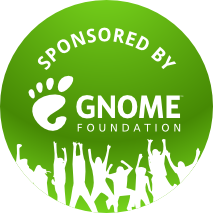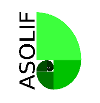GNOME Marketing Hackfest Spring 2010
We got so much done marketing work done last week in Zaragoza, Aragón, Spain. The city was beautiful and I'm more energized and optimistic about the GNOME 3.0 launch than ever before! There were so many smart people with the right skills that came to this hackfest and we achieved so much!
But first, a huge thanks to the hosts of our hackfest, the GNOME Foundation, ASOLIF, CESLA, the municipality of Zaragoza (pronounced like Saragossa), Technological Institute of Aragon (ITA) and the regional government of Aragón:
Also, a few people helped us immensely planning the logistics and in feeling welcome in what, for many of us, was not a language and culture we were familiar with. Alberto Capella, Technological Institute of Aragón, made sure that we had a great hacking space and organized our meetings with the local communities and governments. Agustín Benito Bethencourt, ASOLIF, worked his magic and made sure that everything happened on time; he also made sure we had some great food while we were here. Ignacio Correas, CESLA, also made sure we had a great experience; I enjoyed sharing some beers with him in the local night-life. Daniel Baeyens from the local GNOME community helped with our interfacing with the local community and finding the resources we needed to do video work.
Also, thank you to Paul Cutler and Stormy Peters from GNOME for coordinating the hackfest with the local teams.
Everywhere we went we saw GNOME running on computers! This region is serious about free software!
We began with a recap of the November 2009 Marketing Hackfest which brought all participants up to speed with where the marketing effort was at: what work had already been done. For the most part this was the launch theme, "Made of Easy;" where all of our energy would be spent, on current users of GNOME 2.x; and what materials, broadly, would be produced for the launch: GNOME Ambassador materials, a launch landing page, videos, talking points. Stormy added that GNOME, generally, is messaged as “a desktop that's accessible to anyone, regardless of money or ability.”
“Thank you!” to my co-participants for making it easy to start from there. We could have gotten bogged down in revisiting the November hackfest but everyone accepted the givens and we got right to work.
By the time that the hackfest began, we knew a lot more about what will be in GNOME 3.0 than we did 6 months ago. Additionally, Vincent Untz, of the release team, was able to give us a much more informed view than we've had before. Taken together, we were able to nail down the major features we are going to talk about to the public: the improved user experience (GNOME Shell + search), topic-based help, performance improvements, improved art (symbolic icons) and a new theme, all the great GNOME apps we have now plus great new applications (the details that the release team will decide and then release in the coming weeks).
An important central theme is that, for current users of GNOME 2.x, the experience is a huge improvement over the Windows 95 tyranny that everyone has been living under for the past fifteen years. We have feature parity with GNOME 2.x desktops, but we are taking bold new design decisions in the desktop chrome; taking two steps forward, and no steps backward. GNOME 3 is that new, improved experience with all the great apps you already use and love, continuing to work as that always have. For those who don't want to change, the old panel is scheduled to be maintained for at least another five years for the RHEL 6 release.
On the “no steps backward” point, months ago, there was some concern that there would be a11y related regressions but the Spanish community has been heavily involved in the a11y effort and the team that is working on the last remaining feature that was a concern, the GNOME on-screen keyboard, was there and was able to tell us that they see that being ready in time for 3.0.
We started to discuss some specific examples to throw out to people as examples of the improvements that have been made but we delayed that conversation a little bit until the video team had its meeting the following day. The videos were to be composed of just such examples and so it seemed only logical to do that work there.
With everyone on the same page, over the following three days we made a lot of progress. Others where were on other teams can speak better about their accomplishments (check them out!) but here is my take on the outcomes:
We organized, updated, and created materials used to host a booth or speak at one of the insanely large number of conferences that occur each year around the world. Importantly, the source files for printing a banner, t-shirts, presentations, and brochures are provided so that—when it is impractical to send those around the world—a local team can have the needed items created.
They also brain-stormed some names whom they could ask to become Ambassadors. I won't drop those names here but I think that anyone from the list that they have would be wonderful!
They also spent a lot of time coming up with a technical method by which someone can get a clean, un-distro-ified GNOME desktop to use for demos. The last I heard, they were close to having something based on OpenSUSE Studio's live CD/USB generation site.
Daniel and I hammered away at story boards for six, 30-second videos, first. Those are posted up at the marketing wiki. Namely, we have the following list, but are looking for more ideas:
- GNOME 3 protects you from unwanted interruptions
- GNOME 3 makes it faster, more efficient, and logical to make use of workspaces. No more noobies losing all their windows by accidentally clicking on the workspace switcher icon.
- GNOME 3 makes it easy to rapidly launch applications
- GNOME 3 keeps track of apps and will, by default, bring them to the front rather than launch a new instance. It does, however, not break compatibility with apps that need multiple instances or windows.
- GNOME 3's text editor will have built-in support for many-user collaborative text editing over telepathy-based IM.
- In GNOME 3, Evolution has gained the ability to automatically configure email client settings for a wide range of web-hosted email accounts. This information is continually kept up-to-date on GNOME servers and fetched when adding a new web-hosted email account (like GMail).
Next, we worked out many of the technical details needed for filming both the screen cast components of the videos and the green-screened talking-head segments. I will be creating between one and three such videos from the list above to use as the creative basis for the rest. Those one to three first runs will be done by GUADEC (coinciding with the GNOME 3 launch landing page unveiling) so that more filming can be done at GUADEC. I don't have enough vacation time to make another trip to Europe this year and so we have created a HOWTO posted here that explains how the first videos were created so that a video team at GUADEC can capture more videos; I think that filming at GUADEC also gives us an opportunity for a wide diversity of the GNOME community to be represented in these videos.
An important detail is that—rather than just post the finished, encoded files—we will post all the original source materials needed to remix or create new videos in our community. Localizing the videos becomes easier. Also, this makes it easy to go back to the original videos and update them for any subtle UI changes that happen by early August.
Finally, the end of each video will have a plaque that contains “with GNOME 3”in the lower right leaving a large blank, white space for distribution branding. We want distros to steal these videos and feel free to remix and re-brand them to promote their own distribution. This helps GNOME by synchronizing our message to our users across all distribution marketing efforts (if they should choose to take advantage of this).
The landing-page team, and especially the incredibly awesome Andreas, hammerred out the design of the 3.0 launch site. He posted it up here.
We hammered out, as a large group, the timeline of actions needed to be taken by the marketing team. The list is huge and there's plenty of room for more help! If you're a non-coder, this is one of the many ways to get involved in GNOME. The entire 3.0 launch roadmap is posted here.
On the final day, we all had a discussion about how to help distributions with their messaging about GNOME 3 and also how to talk directly to our base about the diversity of distribution support for GNOME 3. The exciting thing is that GNOME 3 will be available on all distributions at various levels of integration. We'll be communicating with distros to get a better understand of how to position them to our users on our launch site and in other communications.
All in all, it was hugely productive and a great time, too.
GNOME 3.0 is going to rock!




